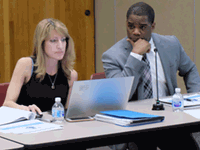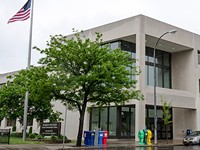[
{
"name": "500x250 Ad",
"insertPoint": "5",
"component": "15667920",
"parentWrapperClass": "",
"requiredCountToDisplay": "1"
}
]
African Americans and Latinx in the nine-county Greater Rochester area are more than three times as likely to be poor as whites are. The median household income for African Americans is less than half that of whites, and the statistic is only slightly better for Latinx.
Whites are more than twice as likely to own homes as African Americans and Latinx are.
Pick almost any indicator of personal well being, and in the Greater Rochester area, African Americans and Latinx are much, much worse off. That's part of the stark story in "Hard Facts: Race and Ethnicity in the Nine-County Greater Rochester Area." The document is the latest report from ACT Rochester, a Rochester Area Community Foundation initiative that provides periodic assessments of the region's well-being in such areas as poverty, health, and education.
More troubling: the numbers are worse in this region than they are for African Americans and Latinx in the state as a whole, and they're worse than they are nationally. The poverty rate of African Americans in Rochester's nine-county region is higher than the state and national averages for African Americans. The child poverty rate for African Americans and Latinx is worse than for those in the state and the nation. So is proficiency in English and in math. The rate of home ownership is lower for African Americans and Latinx than the rate for African Americans and Latinx statewide and nationally.
Low birth rate, infant mortality, high-school graduation rates: everything's worse for African Americans and Latinx here.
"We have a belief that Rochester is a community that excels," Ed Doherty, the report's principal author, said in an interview, "and that's not true." The data are clear about that. In almost any measure of community well-being, Rochester ranks near the bottom, in the state and nationally.
The core statistics in the report – the severity of the poverty and the severity of related issues such as education and health – aren't new. But unlike previous reports, "Hard Facts" focuses specifically on the well-being of people of color. While many white residents in the region live in poverty, and suffer from its effects, poverty is hitting a disproportionate percentage of people of color.
All of this not only has a life-long impact on the affected people, but it also affects future generations. And it affects the economic health of the region.
And significantly, the "Hard Facts" report notes, this didn't just happen. The disparity is the result of specific actions – some deliberate, some seemingly an unintended consequence. The data in the report "clearly point to the profound entrenchment of structural racism," says the report's executive summary.
The report offers this definition of structural racism: "A system in which public policies, institutional practices, cultural representations, and other norms work in various, often reinforcing, ways to perpetuate racial group inequity."
One example: redlining practices in real estate and banking, which have deliberately steered white homeowners to some neighborhoods and people of color to others. Another: zoning codes that require residential lots to be a certain size, or that ban apartments, which results in excluding poor people, a disproportionate number of whom are African American and Latinx.
"Hard Facts" author Ed Doherty gives another example: seniority rules in labor agreements. The purpose is to protect older employees who have given their service to an employer for years and are earning higher salaries. But if the majority of those older employees are white, the result can be to limit the number of people of color who can be hired, even when an employer wants to have a more diverse work force. The seniority rule was not designed specifically to be racist, but the result is the same as if it had been.
What to do about all of this? Doherty is blunt: Rochester needs to stop believing that we're better than other communities, "because we're not."
"This is about leadership," Doherty said. "Political, business, and community leaders cannot look at this data and say that this doesn't require serious action."
"This is not a problem that will be solved by minor tweaking," Doherty said. "It will require something new."
Top on Doherty's list:
1) "We have to start finding strategies that break up the concentration of poverty. We haven't done that. It's not being pursued, in any way."
That is not popular with many African-American leaders, and Doherty said he understands that perspective. "But it's critical" to deal with poverty concentration, he said. "It will allow us to produce institutions that will be productive" – enabling teachers to do a better job, for example, he said.
2) Find a way to encourage "system-wide diversity of employment." "We don't do it," Doherty said, "even in the government sector. We have to find a way to provide equal opportunity to people of color."
3) "We have to find some way of improving public education."
The full report is available at actrochester.org.
Speaking of...
Latest in News
More by Mary Anna Towler
-

Police reform: advocates on what should come next
Oct 22, 2019 -

Court clears the way for Police Accountability referendum
Oct 17, 2019 -

Dade outlines initial actions on district deficit
Oct 9, 2019 - More »










